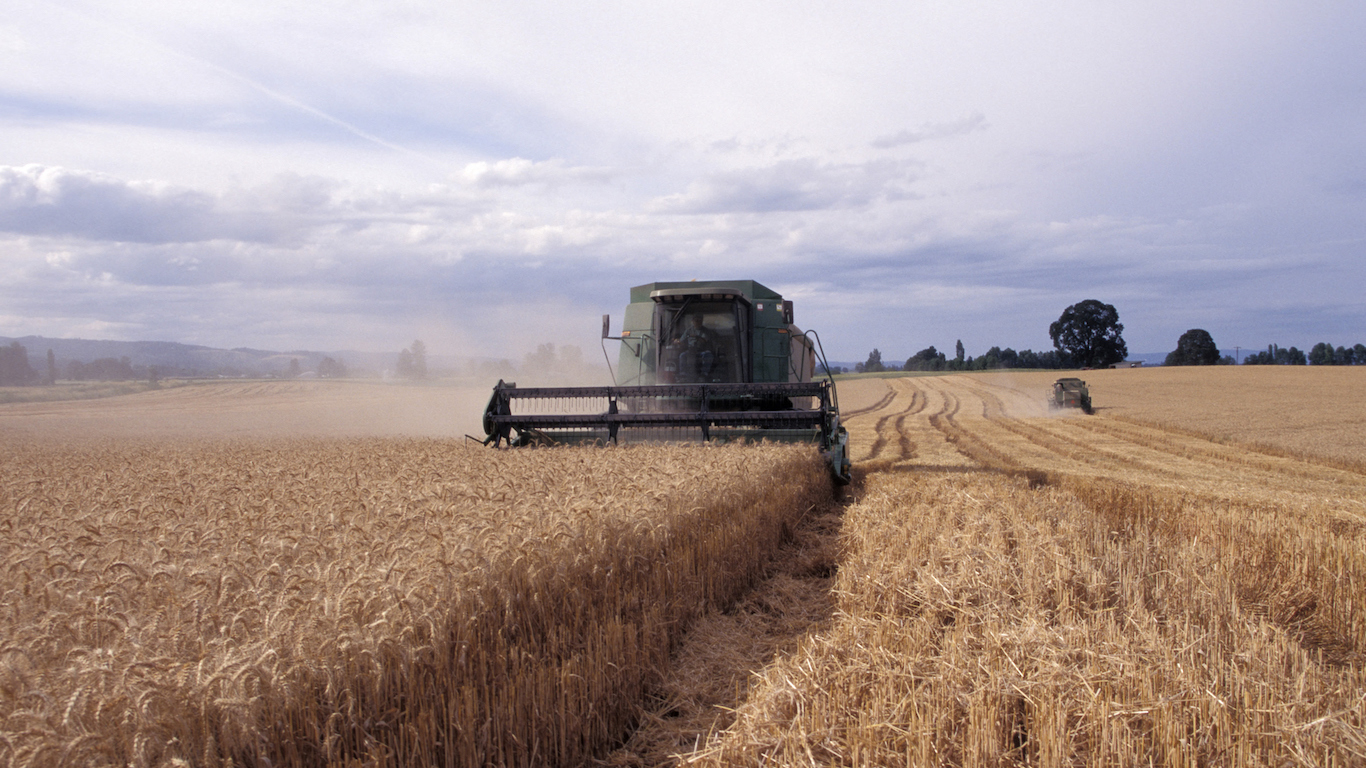Special Report
America's 25 Thriving Industries

Published:
Last Updated:

The United States added 5.7 million jobs to the economy over the past decade. Jobs were not added evenly across all industries, with some shedding jobs and others adding them. In some industries, employment grew much faster than in others. In seven, employment more than doubled, including one industry in which employment nearly tripled.
To determine the industries with the fastest employment growth, 24/7 Wall St. analyzed employment data from the Bureau of Labor Statistics. These thriving industries had the largest percentage increase in employment between 2006 and 2015. For reference, employment across all occupations in the United States grew by 4.2%. Employment in services for the elderly and disabled grew the most of any industry, expanding by 200% as it added more than 1 million workers.
[in-text-ad]
A number of economic and demographic trends contributed to some of the largest employment changes of the past decade. One of the most significant demographic shifts is the transition of the baby boom generation into old age. By 2020, the population of Americans aged 65 and over will outnumber the population 5 and under for the first time in history. While the millions of baby boomers entering retirement may lead to a pension crisis, the demographic shift has created thousands of new jobs in the health care sector. The health care and social assistance industries together added more than 3.8 million jobs in the last 10 years, more than any other sector.
Click here to see America’s 25 thriving industries.
Click here to see America’s 25 dying industries.
One of the fastest growing industries of the past decade is goat farming. Goat meat features prominently in many Hispanic, Middle Eastern, Southeast Asian, and Caribbean diets. These diets are growing in popularity as the share of the U.S. population that is foreign born reaches an historic high. Roughly 14% of the U.S. population today is foreign born, the result of an estimated 59 million immigrants moving to the country in the last 50 years. As that share continues to grow, other industries that cater to a diverse array of ethnicities and cultures will be in high demand. The number of translation and interpreters, for example, grew the second most of any industry workforce.
There are 22.0 million more Americans today than there were 10 years ago. The typical U.S. household today is roughly $7,300 wealthier, and there are 1.6 million more undergraduates attending college. According to the BLS, the U.S. economy is becoming more competitive, and there are a number of industries that will benefit from increased competition.
The highly specialized technical consulting workforce, for example, grew faster than that of all but 13 other industries. Employment in educational support services, which includes businesses such as educational consulting and testing services, grew 20 times faster than the average occupation.
To identify the nation’s 25 thriving industries, 24/7 Wall St. reviewed employment growth from 2006 through 2015 in 704 U.S. industries in the fourth level of detail in the North American Industry Classification System (NAICS) published by the federal government. All data, including the number of establishments within each industry and average annual wages for 2006 and 2015, came from the U.S. Bureau of Labor Statistics Quarterly Census of Employment and Wages (QCEW). Job outlook for some occupations was based on analysis in the BLS Occupational Outlook Handbook. The 2015 industry employment data was organized via 2012 NAICS codes, and the 2006 data was organized via 2002 NAICS codes. To ensure that all 10-year employment changes reflected natural growth, we excluded industries that were redefined during the reference period. This applied to one industry that was excluded, NAICS 51791: Other telecommunications.
These are the nation’s 25 thriving industries.

25. Distilleries
> Employment growth 2006-2015: 57.2%
> Employment total: 11,075
> Wage growth 2006-2015: 7.2%
> Avg. annual wage: $75,999
Taste in alcohol beverages among American consumers has shifted over the past decade from large, mainstream beer brands to smaller craft brews, as well as wines and liquors. While the number of distillery employees grew 57.2% from approximately 7,000 in 2006 to 11,100 in 2015, the number of new distilleries grew even faster. The number of distillery establishments increased from 80 to 560 in that time, according to the BLS. The sevenfold increase was the third fastest establishment growth of any industry.
[in-text-ad]

24. All other pipeline transportation
> Employment growth 2006-2015: 58.0%
> Employment total: 580
> Wage growth 2006-2015: 6.7%
> Avg. annual wage: $70,373
The industry all other pipeline transportation comprises establishments engaged in the transportation of materials other than crude oil and natural gas, such as coal or slurry. While the BLS projects above average employment growth in alternative energy industries, employment in conventional energy industries has continued to expand in the last decade. The number of workers in all other pipeline transportation grew 58.0% between 2006 and 2015, far faster than the 4.2% average growth across all occupations.

23. Sports and recreation instruction
> Employment growth 2006-2015: 58.5%
> Employment total: 115,669
> Wage growth 2006-2015: 15.3%
> Avg. annual wage: $18,203
The number of sports and recreation instructors has surged over the past decade from 73,000 to 115,700. One likely reason is the increase in childhood obesity throughout the United States. The obesity rate has more than doubled among children and quadrupled among adolescents over the past 30 years. As health risks among youth increase, all levels of government have established programs intended to combat this trend. Demand for sports and recreation instructors may continue to increase as many aging baby boomers require physical therapy and fitness instruction.

22. Wineries
> Employment growth 2006-2015: 58.8%
> Employment total: 57,003
> Wage growth 2006-2015: 2.6%
> Avg. annual wage: $43,295
Americans today drink roughly half a gallon more wine per capita than they did 10 years ago. According to a study the Wine Market Council conducted in 2010 — the year the United States replaced France as the world’s largest consumer of wine — the increase in wine consumption is being driven by changing tastes among millennials and baby boomers. U.S. wine production has also increased, with the number of wineries doubling from 1,900 to 3,800 over the past decade. Employment in the industry grew by 58.8%, far outpacing the 4.2% average growth for all jobs.

21. Rail transportation
> Employment growth 2006-2015: 61.3%
> Employment total: 745
> Wage growth 2006-2015: 3.5%
> Avg. annual wage: $45,284
Employment in rail transportation has increased from 462 in 2006 to 745 in 2015, a 61.3% growth. One reason for the growth is the increase in intermodal freight transport, which uses one container in multiple modes of transportation in order to cut costs. While this method of freight transport may have increased demand for rail transport workers, improvements in shipping productivity — such as double stacking containers or running longer trains — has likely kept wages stagnant. The average salary of rail transportation workers has risen just 3.5% in the past 10 years, far slower than the 24.5% average wage growth across all U.S. occupations.

20. Wheat farming
> Employment growth 2006-2015: 61.6%
> Employment total: 6,488
> Wage growth 2006-2015: 45.0%
> Avg. annual wage: $33,505
The number of wheat farmers in the United States has risen by 61.6% over the past 10 years, far more than the 4.2% average growth across all occupations. While U.S. wheat production is down by approximately 3 million harvested acres over the past decade, increases in technology have led to improved yields. Average wheat yield has advanced from 42.0 bushels per acre in the 2005-06 season to 43.6 in 2015-16, with average prices increasing from $3.42 a bushel to $4.89. This has resulted in wage increases for wheat farmers. The average annual salary grew from $23,108 to $33,505, a 45.0% increase, far greater than the 24.5% average increase across all occupations.
[in-text-ad]

19. Offices of all other health practitioners
> Employment growth 2006-2015: 61.8%
> Employment total: 133,582
> Wage growth 2006-2015: 15.0%
> Avg. annual wage: $42,719
Offices of all other health practitioners employ health care professionals other than physicians, dentists, chiropractors, optometrists, mental health specialists, physical, occupational, and speech therapists, or audiologists. These other occupations include acupuncturists, midwives, dietitians, podiatrists, and homeopaths. Demand for such services is likely to continue to grow as the aging baby boom generation continues to require increased medical attention and health care providers expand their coverage to include such care.

18. Oil and gas pipeline construction
> Employment growth 2006-2015: 62.4%
> Employment total: 135,489
> Wage growth 2006-2015: 44.5%
> Avg. annual wage: $78,333
The number of oil and gas pipeline construction workers increased by 62.4% between 2006 and 2015. While the BLS projects above average growth in alternative energy production, employment in conventional energy industries has continued to expand in the past decade. Average oil and gas pipeline construction wages have also increased substantially, from $54,196 a year to $78,333.

17. Other outpatient care centers
> Employment growth 2006-2015: 64.1%
> Employment total: 543,697
> Wage growth 2006-2015: 31.6%
> Avg. annual wage: $67,205
The other outpatient care centers industry excludes outpatient care facilities such as family planning centers, mental health clinics, or substance abuse treatment centers. Examples of outpatient care within the industry include dialysis clinics, sleep disorder centers, and community health clinics. Like most medical professions, employment growth in other outpatient care centers is closely tied to the aging of the baby boom generation. The number of workers in other outpatient care centers increased from 331,333 in 2006 to 543,967 in 2015, a 64.1% growth.

16. Materials recovery facilities
> Employment growth 2006-2015: 64.3%
> Employment total: 18,280
> Wage growth 2006-2015: 5.5%
> Avg. annual wage: $45,217
One of the most important steps in the recycling process is the separation and sorting of recyclable materials from garbage and waste. This process is done in materials recovery facilities. Recycling in the United States has increased substantially over the last 50 years, with the first municipal recycling programs taking off in the early 1970s. In the past decade alone, the share of trash that was recycled or composted rose from 31.4% of all municipal solid waste to 34.6%, a difference of nearly 10 million tons of waste. Employment in the industry has increased to keep up with the growing volume of recycled waste. The number of materials recovery facility workers rose by 64.3% between 2006 and 2015, far more than the 4.2% average across all U.S. occupations.

15. Media buying agencies
> Employment growth 2006-2015: 66.1%
> Employment total: 15,663
> Wage growth 2006-2015: 48.1%
> Avg. annual wage: $111,220
Media buying agencies primarily act as an intermediary between media outlets and advertisers. They buy advertising time and space in print, online, television, radio and other media outlets and resell it to advertisers or companies. While advertising in newspapers and magazines has declined in recent years, advertising on other platforms, particularly those that target mobile devices, has increased. Employment in the media buying industry increased by 66.1% in the past decade and wages have also grown substantially. The average salary of a media buying agent is $111,220 a year, a 48.1% increase from 10 years ago.
[in-text-ad]

14. Other technical consulting services
> Employment growth 2006-2015: 77.2%
> Employment total: 201,767
> Wage growth 2006-2015: 29.2%
> Avg. annual wage: $84,155
The other technical consulting services industry classification includes relatively specialized consultancies, such as agricultural consulting, motion picture consulting, economic consulting, and security consulting. Employment in the sector grew by 77.2% from 113,900 in 2006 to 201,800 in 2015, far faster than the average occupation. The BLS forecasts that employment in the industry will continue its rapid expansion, as a growing economy will make companies more competitive and increase their demand for consulting services. The BLS projects that the smaller, more specialized consultancies will be in the greatest demand.

13. Educational support services
> Employment growth 2006-2015: 79.8%
> Employment total: 158,178
> Wage growth 2006-2015: 31.4%
> Avg. annual wage: $47,365
The educational support services industry mostly comprises establishments that provide education-related services other than teaching and instruction such as educational consulting, testing services, or student exchange programs. The educational support services industry has expanded rapidly in the past decade, increasing from approximately 88,000 employees in 2006 to 158,200 in 2015, as the number of establishments grew from 9,400 to 15,700 over the same period. One reason for the massive growth may be the increasing competitiveness of college admissions. Applications have increased at more than 70% of colleges in 10 of the last 15 years. With more students applying for higher education institutions, applicants have a lower chance of being accepted. Some likely seek out educational support services to increase their chances.

12. Breweries
> Employment growth 2006-2015: 87.1%
> Employment total: 48,401
> Wage growth 2006-2015: -10.1%
> Avg. annual wage: $60,456
The number of U.S. breweries has risen dramatically over the past decade, from 400 establishments in 2006 to 2,200 in 2015. One major reason for the rapid industry growth is the changing beer tastes among American consumers. Younger drinkers are continually choosing small craft beer brands over large mainstream brands. In 2013, Americans consumed more craft beer than Budweiser for the first time ever, at 16.1 million barrels of craft to Budweiser’s 16.0 million barrels. While beer prices have risen since 2006, the average annual wage for brewery employees fell by 10.1% over the last 10 years. By contrast, wages rose by 24.5% across all occupations nationwide.

11. Mobile food services
> Employment growth 2006-2015: 92.1%
> Employment total: 15,272
> Wage growth 2006-2015: 24.2%
> Avg. annual wage: $17,571
The mobile food services industry includes operations such as ice cream trucks, food concession stands, hot dog carts, and food trucks. Food trucks are relatively inexpensive investments compared to most other food services, requiring little more than a street permit. This has allowed more people to open such a business. The number of mobile food service establishments more than doubled in the past decade, from 1,600 in 2006 to 3,600 in 2015. Despite increasing steadily over the last 10 years, wages for mobile food vendors remain low. The average mobile food vendor earns just $17,571 annually, about $2,000 less than the average across the food services sector as a whole and $35,000 less than the average for all occupations.

10. Goat farming
> Employment growth 2006-2015: 92.2%
> Employment total: 517
> Wage growth 2006-2015: 29.0%
> Avg. annual wage: $29,422
Growth in goat farming, like in several other growing U.S. industries, is being driven by the increasing ethnic diversity within the country. Goat meat and goat milk feature prominently in many Hispanic, Middle Eastern, Southeast Asian, and Caribbean diets, which are growing in popularity as the share of foreign born U.S. residents reaches an historic high. The number of goat farmers has nearly doubled over the past decade, increasing from 269 in 2006 to 517 in 2015. About 30 new goat farms opened in the same period, and goat meat production has grown considerably. According to the USDA, the number of goats slaughtered has doubled every decade for the past 30 years.
[in-text-ad]

9. Pet care, except veterinary, services
> Employment growth 2006-2015: 92.7%
> Employment total: 95,784
> Wage growth 2006-2015: 16.8%
> Avg. annual wage: $20,204
Pet care services like boarding, grooming, sitting, and training, are growing in popularity faster than nearly any other industry. Pet care is a luxury service and is likely to continue to increase as incomes rise across the country. According to the American Pet Products Association, the pet industry has grown from $38.5 billion in total spending in 2006 to $60.3 billion in 2015. An estimated 60% of all market spending comes from high-income households, a factor that helped the industry maintain steady growth through the most recent recession. Recent high-end innovations from pet service entrepreneurs, such as luxury pet hotels, pet fitness technology, and haute pet cuisine, have bolstered spending in the industry. Despite the industry boom, the average annual wage of $20,200 for pet care services workers remains far lower than the $52,900 average across all occupations nationwide.

8. All other professional and technical services
> Employment growth 2006-2015: 99.6%
> Employment total: 134,841
> Wage growth 2006-2015: 33.6%
> Avg. annual wage: $74,069
Some examples of businesses included in the all other professional and technical services industry classification are marine surveyor services, arbitration and conciliation services, pipeline or power line inspection services, forecasting services, consumer credit counseling services, weather forecasting services, and handwriting analysis services. While the 99.6% employment growth in such a diverse array of service offerings cannot be attributed to a single trend, the boom is likely part of an increase of small business overall. The number of small businesses in the United States has increased by 49% since 1982 and today accounts for a majority of all U.S. employment. Average establishment size has declined across all industries, and the BLS projects that the demand for small companies with specialized services will continue to grow in the near future.

7. Soybean farming
> Employment growth 2006-2015: 106.3%
> Employment total: 4,557
> Wage growth 2006-2015: 31.0%
> Avg. annual wage: $33,429
The USDA forecasts the United States will harvest 48.9 bushels of soybeans per acre in 2016, a record high yield. Increased yield, lower production costs, and increasing soybean demand worldwide have led to massive employment growth in U.S. soybean farming and has strengthened the country’s position as the world’s leading soybean producer. The number of soybean farmers more than doubled in the past decade, rising from 2,209 in 2006 to 4,557 in 2015. The number of soybean farms grew at a similar pace, increasing from 425 to 936.

6. Apiculture
> Employment growth 2006-2015: 106.4%
> Employment total: 3,116
> Wage growth 2006-2015: 30.0%
> Avg. annual wage: $36,583
The number of apiculture establishments — beekeeping farms — has increased from 278 to 474 over the past decade. Bees have a number of commercial uses, including honey production, beeswax for cosmetic products, bee pollen as a health supplement, and crop pollination. Recently, industry growth has been driven by increased demand for crop pollination. An estimated two-thirds of the 2.5 million bee colonies in the United States were rented for pollination services. Increased demand for bee pollination is largely a result of increased U.S. almond production, which utilizes the bulk of the nation’s rental bee colonies. Employment in apiculture grew faster than nearly any other industry in the last 10 years, rising from 1,510 workers in 2006 to 3,116 in 2015.

5. Administration of veterans’ affairs
> Employment growth 2006-2015: 119.5%
> Employment total: 54,251
> Wage growth 2006-2015: 22.2%
> Avg. annual wage: $74,593
The U.S. Department of Veterans Affairs provides health care, benefits, and other services to the nation’s veterans, and it may continue to grow as a larger share of veterans enter old age. An estimated 46% of veterans today are 65 and older, a share projected to steadily increase over the next 15 years. While employment in the government sector is in line with levels a decade ago, the number of workers in veterans’ affairs administration has more than doubled. There are currently 54,000 employees to serve 21.4 million U.S. veterans, up from 24,715 in 2006. The organization has grown support greater demand. There were 13.4 million more visits in 2013 to outpatient health facilities by veterans than in 2009, a substantial increase.
[in-text-ad]

4. Other grain farming
> Employment growth 2006-2015: 123.7%
> Employment total: 21,819
> Wage growth 2006-2015: 40.5%
> Avg. annual wage: $35,988
The other grain farming industry comprises farms that produce grains other than wheat, corn, or rice. Examples include barley, rye, wild rice, or sorghum farms. Over the past decade, the number of industry employees grew 123.7%, from 9,800 workers in 2006 to 21,800 in 2015. By comparison, employment across all U.S. industries grew by 4.2% over the same period. A number of volatile factors can impact U.S. grain production and prices, including government subsidies, the strength of the dollar, weather, and grain production in other countries. Grain production and prices have risen in most of the last 10 years. Additionally, the growing popularity of certain grains such as quinoa has led many American farms to start producing the grain.

3. Dry pea and bean farming
> Employment growth 2006-2015: 141.8%
> Employment total: 764
> Wage growth 2006-2015: 61.7%
> Avg. annual wage: $33,597
Employment in the dry pea and bean farming industry has expanded more than in nearly any other U.S. industry. Most industry farms produce beans, cowpeas, garbanzo beans, lentils, lima beans, and peas. While most dry peas in Europe and North America are used for animal feed, dry peas produced in the United States are more often intended for human consumption. After large fluctuations, dry pea and bean production in the U.S. is up from 10 years ago. Employment rose from 316 in 2006 to 764 in 2015, a 141.8% increase. The 61.7% increase in wages was also above average. One reason for the increased bean production is the growing demand for hummus. Total U.S. sales of hummus, which is made from garbanzo beans, also known as chickpeas, grew from $5 million in 1997 to $250 million in 2013.

2. Translation and interpretation services
> Employment growth 2006-2015: 168.5%
> Employment total: 31,276
> Wage growth 2006-2015: -8.1%
> Avg. annual wage: $45,570
The number of translators and interpreters in the United States grew 168.5% in the past decade, from 11,647 to 31,276, the second largest increase of any industry. The BLS projects that employment will continue to grow in the near future as the world becomes increasingly globalized, and the share of U.S. foreign-born citizens continues to grow. Roughly 14% of the U.S. population today is foreign born, the result of an estimated 59 million immigrants moving to the country in the last 50 years. Pew Research Center projects that by 2055 there will be no single racial majority. While demand for the profession has grown in the last 10 years, wages have not. The average income for translators and interpreters declined 8.1%, even as nationwide wages for all occupations grew 24.5%.

1. Services for the elderly and disabled
> Employment growth 2006-2015: 199.8%
> Employment total: 1,576,488
> Wage growth 2006-2015: -6.7%
> Avg. annual wage: $17,143
Employment in no industry has grown more over the past decade than in services for the elderly and disabled. Employment in services for the elderly and disabled, such as adult day care, nonmedical home care, or companionship, has tripled in the last 10 years. The number of workers increased from 526,000 in 2006 to 1.6 million in 2015. Services for the elderly and disabled was the only industry to add more than 1 million workers in that period. Industry growth will likely endure as aging baby boomers continue to require increased medical attention. According to the U.S. Census Bureau, the population of Americans aged 65 and over will outnumber the population 5 and under for the first time in history by 2020.
Credit card companies are pulling out all the stops, with the issuers are offering insane travel rewards and perks.
We’re talking huge sign-up bonuses, points on every purchase, and benefits like lounge access, travel credits, and free hotel nights. For travelers, these rewards can add up to thousands of dollars in flights, upgrades, and luxury experiences every year.
It’s like getting paid to travel — and it’s available to qualified borrowers who know where to look.
We’ve rounded up some of the best travel credit cards on the market. Click here to see the list. Don’t miss these offers — they won’t be this good forever.
Thank you for reading! Have some feedback for us?
Contact the 24/7 Wall St. editorial team.